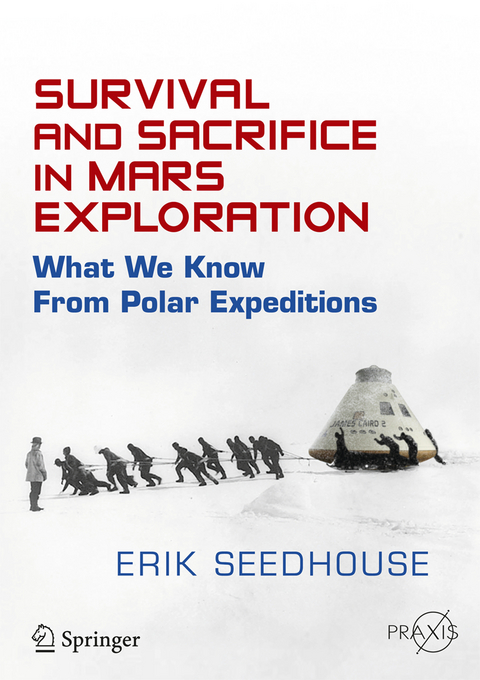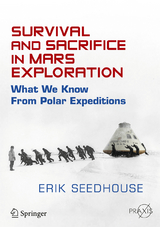Survival and Sacrifice in Mars Exploration
Springer International Publishing (Verlag)
978-3-319-12447-6 (ISBN)
With current technology, a voyage to Mars and back will take three
years. That's a lot of time for things to go wrong. But sooner or later
a commercial enterprise will commit itself to sending humans to Mars.
How will the astronauts survive? Some things to consider are:
ith current technology, a voyage to Mars and back will take threeyears. That's a lot of time for things to go wrong. But sooner or later
a commercial enterprise will commit itself to sending humans to Mars.
How will the astronauts survive? Some things to consider are:
- Who decides what medical resources are used for whom?
Who decides what medical resources are used for whom?- What is the relative weight of mission success and the health of the
crew?
What is the relative weight of mission success and the health of thecrew?
- Do we allow crewmembers to sacrifi ce their lives for the good of themission?
Do we allow crewmembers to sacrifi ce their lives for the good of themission?
- And what if a crewmember does perish? Do we store the body for
return to Earth or give the member a burial in space?
Questions like these, and hundreds of others, have been explored by
science fi ction, but scant attention has been paid by those designing
missions. Fortunately, the experience gained in polar exploration more
than 100 years ago provides crews and mission planners with a framework
to deal with contingencies and it is this that forms the core of this book.
Why the parallels between polar and space exploration? Because polar
exploration offers a better analogy for a Mars mission today than those
invoked by the space community. Although astronauts are routinely
compared to Lewis and Clark, Mars-bound astronauts will be closer in their
roles to polar explorers. And, as much as space has been described as a
New Frontier, Mars bears greater similarity to the polar regions, which is
why so much can be learned from those who ventured there.
And what if a crewmember does perish? Do we store the body forreturn to Earth or givethe member a burial in space?Questions like these, and hundreds of others, have been explored by
science fi ction, but scant attention has been paid by those designing
missions. Fortunately, the experience gained in polar exploration more
than 100 years ago provides crews and mission planners with a framework
to deal with contingencies and it is this that forms the core of this book.
Why the parallels between polar and space exploration? Because polar
exploration offers a better analogy for a Mars mission today than those
invoked by the space community. Although astronauts are routinely
compared to Lewis and Clark, Mars-bound astronauts will be closer in their
roles to polar explorers. And, as much as space has been described as a
New Frontier, Mars bears greater similarity to the polar regions, which is
why so much can be learned from those who ventured there.
Dr. Erik Seedhouse worked as an Astronaut Training Consultant for Bigelow Aerospace in 2005, a company for whom he wrote the Spaceflight Participants Flight Surgeon's Manual. He also developed astronaut-training protocols for future spaceflight participants and wrote and edited several chapters of Bigelow Aerospace's Astronaut Training Manual. Erik is a research scientist specializing in environmental life sciences and physiology, the subject in which he obtained his PhD in Physiology while working for the European Space Agency between 1996 and 1998. In 2009, he was one of the final candidates for selection as an astronaut in the CSA's Astronaut Recruitment Campaign. He is also Training Director for for Hire.
Exploration Mission Architectures.- Expedition Leadership.- Bioethics.- Launch and Outbound.- Approach and Landing.- Surviving.- Sacrifice and Death.- Inbound.- Return.
| Erscheint lt. Verlag | 8.4.2015 |
|---|---|
| Reihe/Serie | Space Exploration | Springer Praxis Books |
| Zusatzinfo | XXV, 163 p. 79 illus., 58 illus. in color. |
| Verlagsort | Cham |
| Sprache | englisch |
| Maße | 168 x 240 mm |
| Gewicht | 334 g |
| Themenwelt | Sachbuch/Ratgeber ► Natur / Technik ► Weltraum / Astronomie |
| Naturwissenschaften ► Physik / Astronomie ► Astronomie / Astrophysik | |
| Technik ► Luft- / Raumfahrttechnik | |
| Schlagworte | Arctic Exploration • Astronaut training • Behavioural Challenges • Bone Deconditioning • Landing on Mars • Life support systems • Mars Exploration • Mission architecture • Polar Expedition Survival • Radiation Hazards in Space • Space rescue missions |
| ISBN-10 | 3-319-12447-1 / 3319124471 |
| ISBN-13 | 978-3-319-12447-6 / 9783319124476 |
| Zustand | Neuware |
| Informationen gemäß Produktsicherheitsverordnung (GPSR) | |
| Haben Sie eine Frage zum Produkt? |
aus dem Bereich




